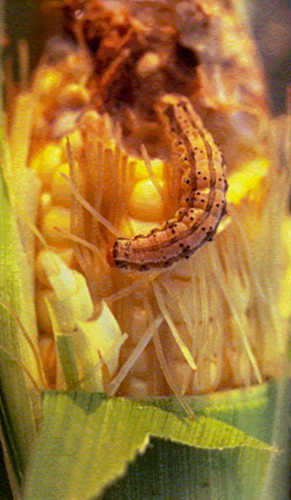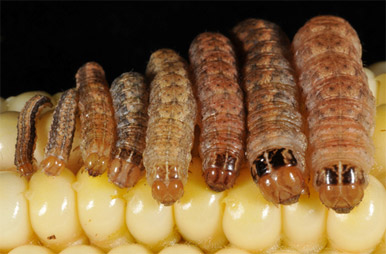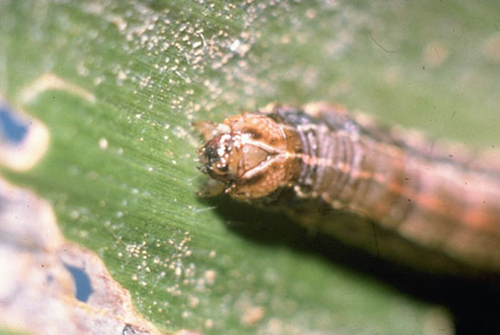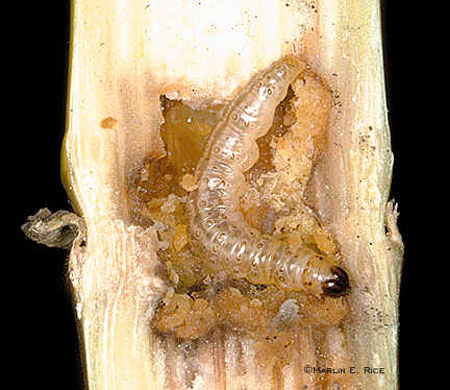Agronomy Update: Mid to Late Season Insect and Disease Watch
BY DAIRYLAND SEED AGRONOMY TEAM
Most Common Corn Ear Feeding Larvas
There have been reports of corn earworm and western bean cutworm feeding on corn ears. It seems timely to briefly describe the life cycle and physical descriptions of the most common corn ear feeding larvas. Corn ear feeding larva not only cause damage to the grain but, can predispose the damaged kernels to harmful fungi that cause ear rots. European corn borer may cause additional damage by boring into the stalk or into the ear shank causing premature stalk lodging or ear drop, respectively.
| EUROPEAN CORN BORER
European Corn Borer (ECB) overwinters in the Midwest and have two and sometimes three generations. Each generation can cause economic damage. The second and third generations are responsible for ear damage and stalk tunneling. They can easily be identified with a hand lens. Each body segment has a circular spot. Most above ground Bt traited corn hybrids will control ECB. To control second and third brood conventionally, two insecticide applications are more consistent than one since egg laying of the adult can span a period of three to six weeks. Once in the stalk or ear, insecticidal treatments are not effective. Later planted corn is at the greatest risk from second and third brood ECB. |
|
|
CORN EARWORM University trapping reports are indicating fairly moderate to high adult populations in some geographies. Corn Ear Worm (CEW) also can be identified easily with a hand lens. Very small triangular spines and dark spots on the body segments separate this larva from others that feed on corn ears. CEW also comes in a large variety of different colors. CEW are cannibalistic, so you will rarely find more than one on an ear. Multiple Bt above ground traited corn hybrids do not control CEW. Insecticidal treatments need to begin soon after tassel. In general, CEW only rarely causes economic grain damage directly to dent corn. Most damage occurs from the ear rots it causes with feeding damage. |
 |
|
WESTERN BEAN CUTWORM Western Bean Cutworm (WBCW) overwinters in the Midwest and generally prefer lighter soil types. Once again, trapping reports are indicating potential economic damage in some areas. WBCW can be identified with stripes running the length of its body. WBCW lacks warts, bumps, or hairs and has two darker rectangular boxes behind its head. Multiple larva may be found on an ear with obvious entry holes on the husk. Not all Bt traited corn hybrids control WBCW. Insecticidal treatments should resume when 90-95 percent of tassels emerge and 70-90 percent of the eggs have hatched. Treatment is ineffective once the larva enter the ear. |
 |
|
FALL ARMYWORM Fall Army Worm (FAW), similar to ECB, prefer late planted or late maturing corn. FAW can feed heavily on foliage and feed on ears. Ear rots may occur due to damage created from feeding damage. FAW can easily be identified by the characteristic inverted white to yellow on the forehead. Most Bt above ground traited corn hybrids control FAW, but not all. Insecticidal treatments may be justified if 75 percent of the corn plants have larva less than 1 inch. If FAW is in the ear treatments are ineffective. |
 |
The bottom line: Corn is in various growth stages of development in some geographies and not all Bt controls certain insects. Understand the traits you have, scout where needed, identify the insect and make adjustments where only needed. If you need assistance please contact your respective Agronomy Team Member.
Mid - Late Season Soybean Disease Watch
Most soybeans are somewhere in the R2-R4 growth stages – blossoms in the top part of the stalk (R2) to full sized flat pods in the top nodes (R4). Bean development and pod fill will be taking place rapidly in the next few weeks. It is a good time to assess plant health, look for any plant disease, and make final fungicide decisions.
The crop is generally healthy across most of the Dairyland footprint. In southern areas, some frogeye can be found but generally not severe. Downy mildew can be seen – a bit of an unusual disease for soybeans – but not severe. Be on the lookout for sudden death syndrome – it will show up very soon if it is out there. Watch especially compacted areas and areas that were planted wet for the development of SDS. And white mold, if it is going to show up, will be seen soon.
Scouting now will identify problem areas. That is important for understanding yield variation across the field and for future planning. For example, SDS areas may indicate moderate to severe compaction issues that may need to be addressed with tillage. Any white mold areas should be flagged in order to manage those spots carefully in the future.
Let us know if you see severe or unusual disease pressure and we’ll be happy to help assess the need for any action.
 |
 |
 |
 |
 |
| Brian Weller Western Region 507.456.3034 |
Dan Ritter Central Region 219.863.0583 |
Branden Furseth Northern Region 608.513.4265 |
Rod King Eastern Region 574.596.6721 |
Terry Jones Eastern Region 419.630.3115 |

